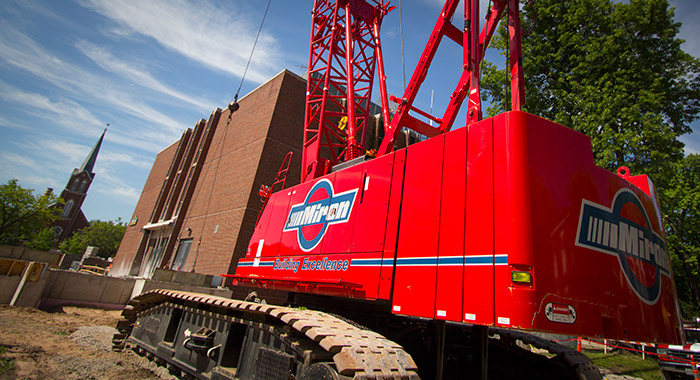Cranes on Campus
Construction barriers, heavy machinery and piles of building materials in the parking lot are generally regarded less as inconveniences and more as indicators of good health on a college campus. With cranes to the east of it and cranes to the west, evidently the prognosis at St. Norbert is a fine one.
Most visible from the street is the conversion of the former St. John’s Church building into the Cassandra Voss Center, which comes into being as the result of one of the largest-ever gift totals for gender programming in higher education. This building is destined to be the new home for the Women’s Center, the Men’s Initiative, and the women’s and gender studies discipline.
Meanwhile, across the academic heart of campus, the largest project ever undertaken by the college is under way as JMS undergoes its transformation into the 150,000-square-foot Gehl-Mulva Science Center. Ground was officially broken May 10. This 27-month project will be completed in phases, with the first phase seeing additions to both the east and west ends of the building.
Space for science is expensive, with its special requirements for services like ventilation, explains John Barnes (Facilities). So one of the focuses of the transformation is the removal of office space from the “scientific core” of the building to its new ancillary spaces.
“It’s going to be a nice building when it’s done,” says Barnes. “It’s really a refocus on science in the existing building. One of the things I’m proud of is, we build a lot of building for the money. I think when we put up a building, we get a lot for our dollar.”
Other construction on campus may be less conspicuous but demonstrates a similar approach to stewardship. Remodeling in Cofrin earlier this semester helped bring most of the staff in the new information technology services division under one roof. And this summer sees the finishing of the hitherto unoccupied lower level of the Mulva Library into a studio-style learning environment.
“The space is designed to meet the need students have expressed for space to spread out with computers, information, and projects – whether individually or in small clusters,” explains Kristin Vogel (Library). They’ll find comfortable, dynamic space that supports academic curiosities, engaged minds and understanding of how to harness the power of information.” Plans at snc.edu/go/studio give a sense of the space, which will also serve as the new home of the college’s TV studio – an amenity available to students as one more option for disseminating the results of their work.
July 2, 2013












